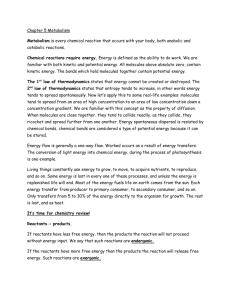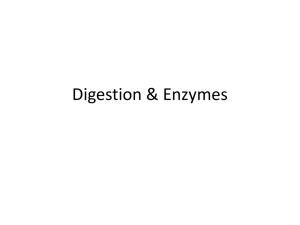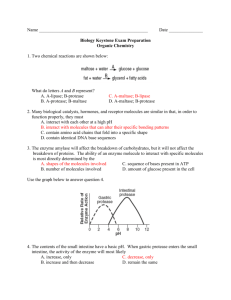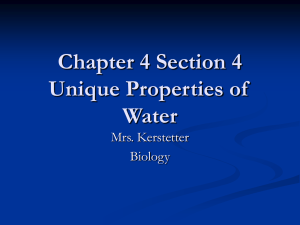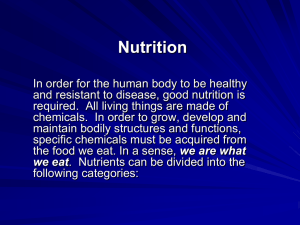Chemistry for Anatomy and Physiology
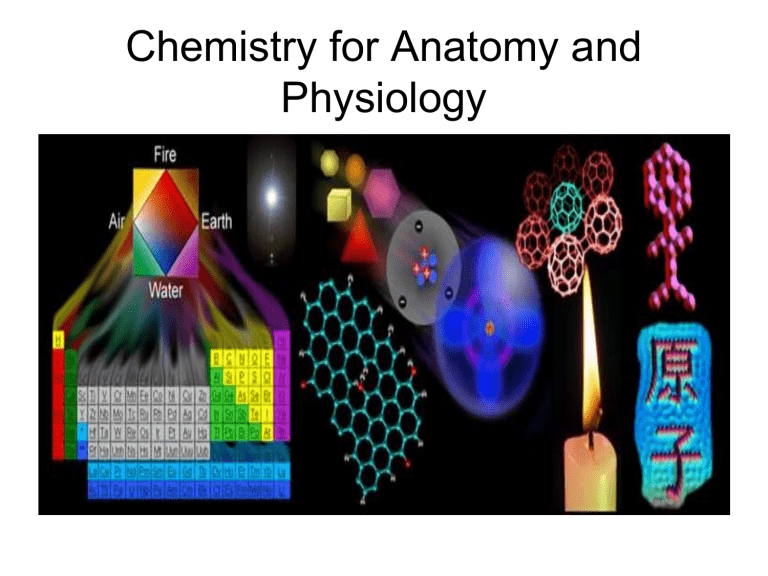
Chemistry for Anatomy and
Physiology
Matter
• Can be seen, smelled or felt
• Occupies space and has mass (weight)
• We look at how building blocks are put together
Energy
• The ability to do work
• Massless; measured by its effect on matter
Types of Energy
• Chemical
• Electrical
• Mechanical
• Radiant
Chemical Energy
Stored in atomic bonds
Released when bonds are broken
Electrical Energy
• Movement of charged particles
• Electrons along a wire at home
• Charged particles across a membrane in your body
Mechanical Energy
• Running, Riding a bike, paddling a canoe…
• Muscle contraction moves the bones of your body
Radiant Energy
• Travels in waves
• Electromagnetic Spectrum
• Includes x-rays, infrared, visible light, radio and
Ultraviolet
• Important in vision and Vitamin D synthesis
Can we convert from one type to another???
• While it is never created or destroyed, some energy is lost as heat.
• Example= Eating, only 10% of the energy is retained and the rest is lost as heat.
Path of Energy
• Begins as sun energy
• Photosynthesis converts sun energy to chemical
• We eat plants and absorb the nutrients
Food to Macromolecules
• When we eat, chemical reactions produce heat
• Keeps our body temperature stable
• Provides building blocks for macromolecules
Energy Storage
• Energy is stored in
ATP molecules for use in all activities
• The energy is stored in the last phosphate bond
• ATP breaks off a phosphate and becomes ADP
ATP and ADP
ATP = Fully Charged
Battery
ADP = Partially Charged
Battery
What good is heat?
• Helps us maintain our body temperature
• Speeds up reactions in our body
• It is part of our ability to maintain homeostasis
Atomic Particles
Location Charge Mass Particle
Proton Nucleus +1
Neutron Nucleus
Electron Orbitals
0
-1
1 amu
1 amu
0 amu
Common Elements
(p30 in 9th)(p28 in 8th)
• The number of
Elem % At # protons identify the
• O 65.0% 8 element and is the
• C 18.5% 6 same as the
• H 9.5% 1 atomic number
• N 3.2% 7
• The atomic mass is
• Ca 1.5% 20 the number of
• P 1.0% 15 protons plus the number of neutrons
Diagram C, H, N, O, P, S
Isotopes
• Iso=same
• Same element; different atomic mass
• Same number of protons
• Different number of neutrons
Radioisotopes
• Heavy isotopes tend to decompose to the lighter form
• The decay is called radioactivity
• Used to “Tag” biological molecules
(PET scan)
• Treatment of certain localized cancers
Type
Ionic
Types of Bonds
Formed When… Characteristics
Electron is
Transferred
Between atoms with different electronegativity
Electron is Shared Very strong bond Covalent
Van der Waals
Forces or
Hydrogen
Bonds
Attraction between oppositely charged regions of molecules
Hydrogen bonds individual = weak many = strong
Radioactivity
• Alpha or Beta particles or gamma rays are given off from the nucleus
• Alpha penetrates the least, gamma, most
• It is the electrons that are sent flying that does damage
Molecules and Compounds
• Molecules are two or more atoms of the same element that are joined
• H
2 or O
2
• Compounds are two or more atoms of different elements join together.
• CH
4 or H
2
O
Ionic – Electron Transferred
Covalent – Electron Shared
Van der Waals Forces (oppositely charged regions )
Synthesis Reaction
• Two or more atoms or molecules combine to form a larger more complex molecule
• A + B → AB
Decomposition Reaction
• When a molecule is broken down into smaller less complex molecules
• AB → A + B
Exchange Reaction
• Involves both synthesis and decomposition. Bonds are both made and broken and a switch is made
• AB + CD → AD + BC
Organic vs Inorganic
Organic = Carbon Inorganic = No Carbon
Inorganic
Properties of Water
• #1
High Heat
Capacity
• Water can absorb or release large amounts of heat before its temperature changes
• Prevents temperature changes in our body
Properties of Water
#2 Polarity
• Water molecules have a slightly negative charge near the oxygen atom and a slightly positive charge around the hydrogen atom.
Properties of Water
#2 Universal Solvent
• Water dissolves more substances than sulfuric acid because of its polar characteristic. It can surround molecules of a substance and pull it apart.
Water Properties
• #3 Chemical Reactivity
• Can break down molecules into smaller less complex forms
• Hydrolysis Reaction
Hydro = Water
Lys = Splitting
Water Properties
• #4 Cushioning
• Protective function in the form of fluid around sensitive organs
• Like: the brain, or a developing fetus
Other Properties of Water
Cohesion
• Water is attracted to other water. This is called cohesion .
Other Properties of Water
Adhesion
• Water can also be attracted to other materials. This is called adhesion .
Other Properties of Water
Density
• Ice is less dense than water which is why it floats.
It expands as it freezes
Fish can live in water during winter
Other Properties of Water
• Surface Tension
• Cohesion of water molecules at the surface of a body of water causes the water to pull itself into a shape with the smallest amount of surface area
(sphere).
• Surface tension allows water striders to 'skate' across the top of a pond.
(Cohesion)
Other Properties of Water
• Capillary Action
• Adhesive properties of water. Placing a straw into a glass of water, it
'climbs' up the straw.
Molecules are attracted to the straw molecules
(adhesion). When one water molecule moves, the other water molecules follow (cohesion)
• Capillary action is limited by gravity and the size of the straw. Plants take advantage of capillary action to pull water into the roots.
Salts
• Ionic Compound
• Dissociate in water to:
Cation + and Anion –
• Calcium and
Phosphorus (bones and teeth) and
Sodium and
Potassium
• ELECTROLYTES conduct current in solution
Acids and Bases
• Acids = Proton donor, in the form of H+ (hydrogen or naked proton)
• Strong acids liberate all of their protons
• Sour / burn
• Bases = Proton acceptor or dissociate to give off OH- ions
(hydroxyl)
• Strong bases give off all OH-
• Bitter / slippery
Neutralization
• Neutral pH is 7
• Combine acid and base to neutralize
• Buffers are weak acid and bases that maintain pH stability by taking up excess
H+ or OH- ions
• If blood is too acidic it will not carry oxygen
Categories of Organic Molecules
• Carbohydrates
• Lipids
• Proteins
• Nucleic Acids
Categories of Organic Molecles
Molecule Building Blocks Examples
Carbohydrates
C H O
Monosaccharides Sugars and
Starches
Lipids
C H O
Proteins
C H N O
Nucleic Acids
C H N O P
Glycerol and
Fatty Acids
Amino Acids
Nucleotides
Fats, Oils,
Waxes and
Steroids
Muscle
Enzymes
Collagen
Antibodies
DNA, RNA
Uses
Quick Energy
Stored Energy
Cell Membranes
Help Carry Out
Cellular Activities
Instructions for all cell activities
Help make proteins
Carbohydrate
Lipids
Protein
Nucleic Acid
Building Blocks
4 Groups of Organic Compounds
Enzymes
Enzymes
• Enzymes =
Catalysts that speed up reactions in our body
• Enzymes have a specific job – each fits like a lock and key with its specific substrate
How Enzymes Work
Four steps in the process of an enzyme working.
1. An enzyme and a substrate (the biological molecule that the enzyme will attack) are in the same area.
2. The enzyme grabs onto the substrate with a special area called the active site which is a specially shaped area of the enzyme that fits around the substrate. The active site is the keyhole of the lock.
3. A process called catalysis happens which is when the substrate is changed ( broken down or combined to make something new)
4. When the enzyme lets go, it returns to normal, ready to do another reaction. The substrate is no longer the same and is now called the product.
Can you stop them????
• Good question!
• There are many factors that can regulate enzyme activity, including temperature, activators, pH levels, and inhibitors.
Any factors that affect the shape of an enzyme affect the enzyme’ s activity. What effect does pH and temperature have on an enzymes ability to catalyze (speed up) a reaction?
• Enzymes work well within very specific ranges of pH and temperature. If the pH or temperature changes to outside of the range, the enzyme shape changes and thus no longer works to speed up the reaction.



